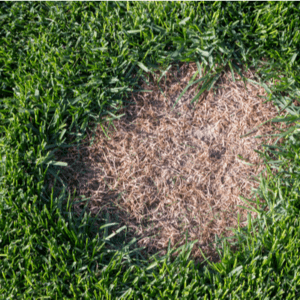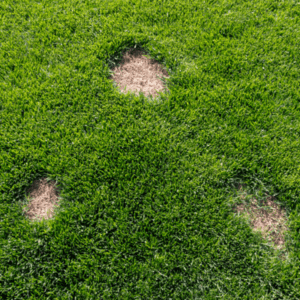Home to Dover International Speedway, smooth coastal beaches, and beautiful state parks, Delaware is also in what the United States Department of Agriculture calls the “transition zone.”
The transition zone is part of the USDA’s plant hardiness zone map which is based on the average annual minimum winter temperature, divided into 10-degree Fahrenheit zones. It is the standard by which gardeners and growers use to determine which plants are most likely to survive in this location.

What does that mean for Delawareans? We face major challenges when planting grass seed. Our winters are too cold for warm-season grasses and our summers are too warm for cool-season grasses, which means most of us have a blend of both. This opens up our lawn to a variety of problems and diseases, some of which can completely destroy an entire yard. The best way to prevent this from happening is to be aware that these diseases exist, how to identify them, and using best practices for avoiding them.
Brown Patch
Brown patch is a lawn disease affecting all types of grasses. It appears as large circular and irregular patches of brown, dead grass. It often appears when the grass has been wet for an extended period or when temperatures drop below 68 degrees. Brown patch is common in early spring and late fall when damp grass doesn’t have enough daylight hours to dry. As the fungus spreads, the infected grass may wither and die, allowing weeds to quickly take over. The biggest problem with Brown Patch is that it spreads rapidly. So, how do you prevent this dreadful disease from destroying your lawn?
Brown Patch Prevention
The key to brown patch prevention is good lawn care practices, especially when it comes to watering. Never over-water your lawn, as sitting moisture can spark the brown patch fungus. Also, make sure your lawn is draining water properly.
Dollar Spot
Dollar spot affects both cool-seasoned and warm-season grass and appears as small patches of white, tan, or straw-colored patches of dead grass on your lawn. The patches are usually about the size of a dollar coin, hence where the disease got its name. Over time, these spots can merge and create large patches of infected turf. It starts out and becomes active in the spring when the temperatures at night reach at least 50 degrees. It takes advantage of drought-weakened grass or grass that has been oversaturated with water for too long. Heavy dew and consistent wet weather help fuel the growth of Dollar Spot.
Dollar Spot Prevention
When it comes to preventing Dollar Spot, the most important factor is irrigation. Dollar spot wreaks havoc on improperly watered lawns. Whether it be too much or too little water, getting it right can mean the difference between healthy grass and diseased grass. Make sure you only water early in the morning. This gives the grass enough time to dry out during the day, reducing the amount of excess water sitting on the grass. Keeping your lawn healthy with a lawn care program that includes consistent fertilization and a proper maintenance schedule is also essential. Invest in aeration services once per year to improve your lawn’s drainage and reduce the excess thatch in your lawn. 
Red thread
is another common lawn disease that affects our Delaware lawns. This tough fungus forms in the lawn during the cooler and wetter weather of spring but continues growing into the summer. As the name suggests, the red thread appears as patches of brown, unhealthy grass with red threadlike growths. Red thread causes grass death from the tip of the blade down, but it doesn’t attack the crown or roots of the grass. The good news is, it won’t kill your grass, but it can severely weaken it, stunting growth and leaving it vulnerable to environmental damage, weeds, pests, and more diseases.
How to Prevent Red Thread
The best way to deal with red thread is to apply a fungicide, but it will take time before completely eliminating the fungus. A balanced fertilizer that is slightly higher in nitrogen will also aid in red thread prevention.
Powdery Mildew
The first sign of powdery mildew is white or gray patches on the tips of the grass blades. This is a disease that loves the shade. As the disease progresses, your grass may look like it is covered in flour. This is a disease that loves the shade. Favorable conditions for powdery mildew include areas with poor air circulation, high humidity, shade, or low light and cool temperatures.
Prevention of Powdery Mildew
One way to help manage powdery mildew is to reduce shade by trimming surrounding trees and shrubs for better sunlight and air circulation. You can also try overseeding with more shade-tolerant grasses.
Quality Cut Lawn Service recognizes the distinctive needs of each of the grasses found in our great state and the vast amount of lawn diseases that affect each. The best protection against any disease or lawn problem is investing in routine lawn care maintenance. We offer a five-step lawn care program that provides the proper amount of fertilization and weed control. We also offer aeration and seeding services. Contact us online now or call us at 302-420-7597 to learn more about each of these programs and how we can help protect your Delaware lawn.
